16.08.2025
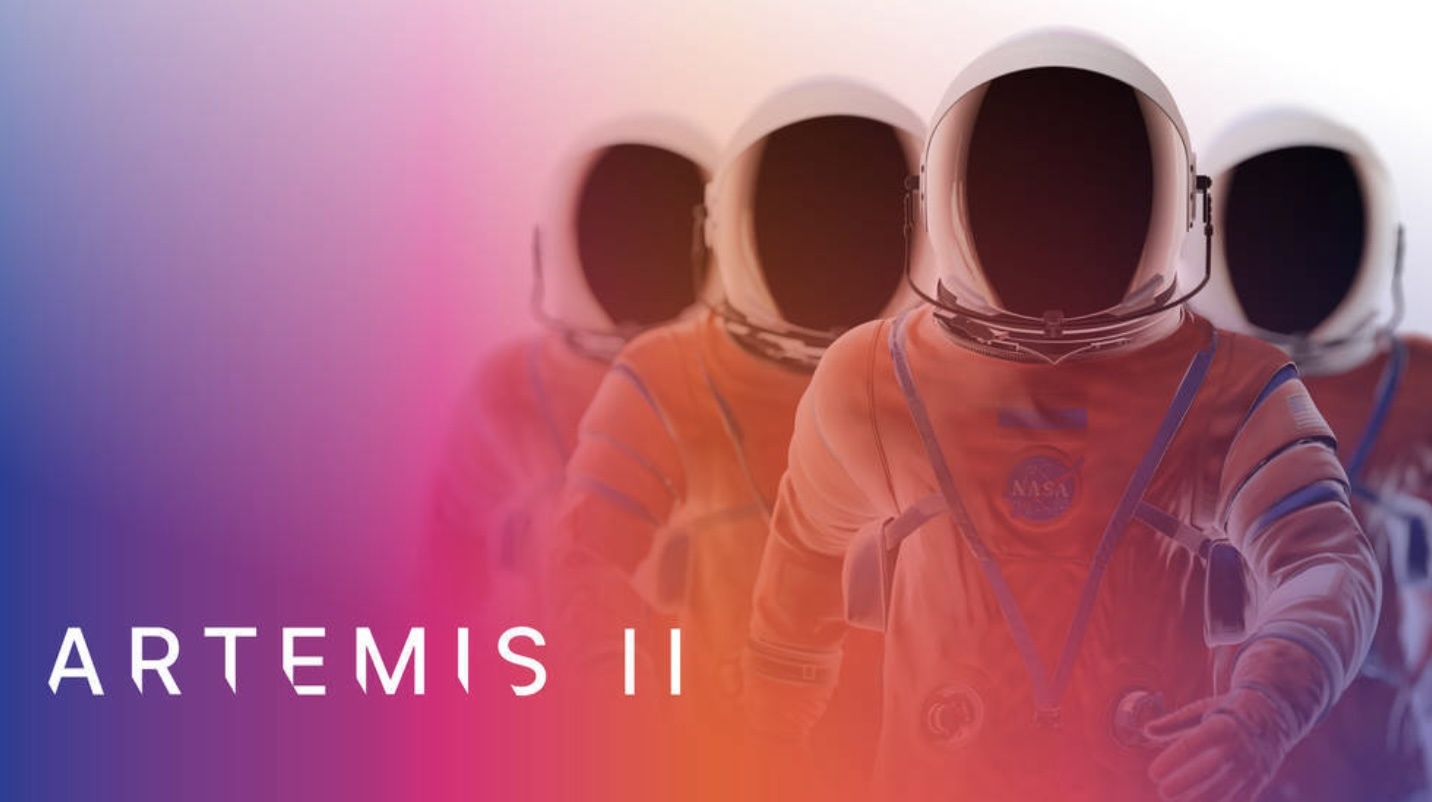
Artemis II Crew Train for Night Launch Scenarios at Kennedy Space Center
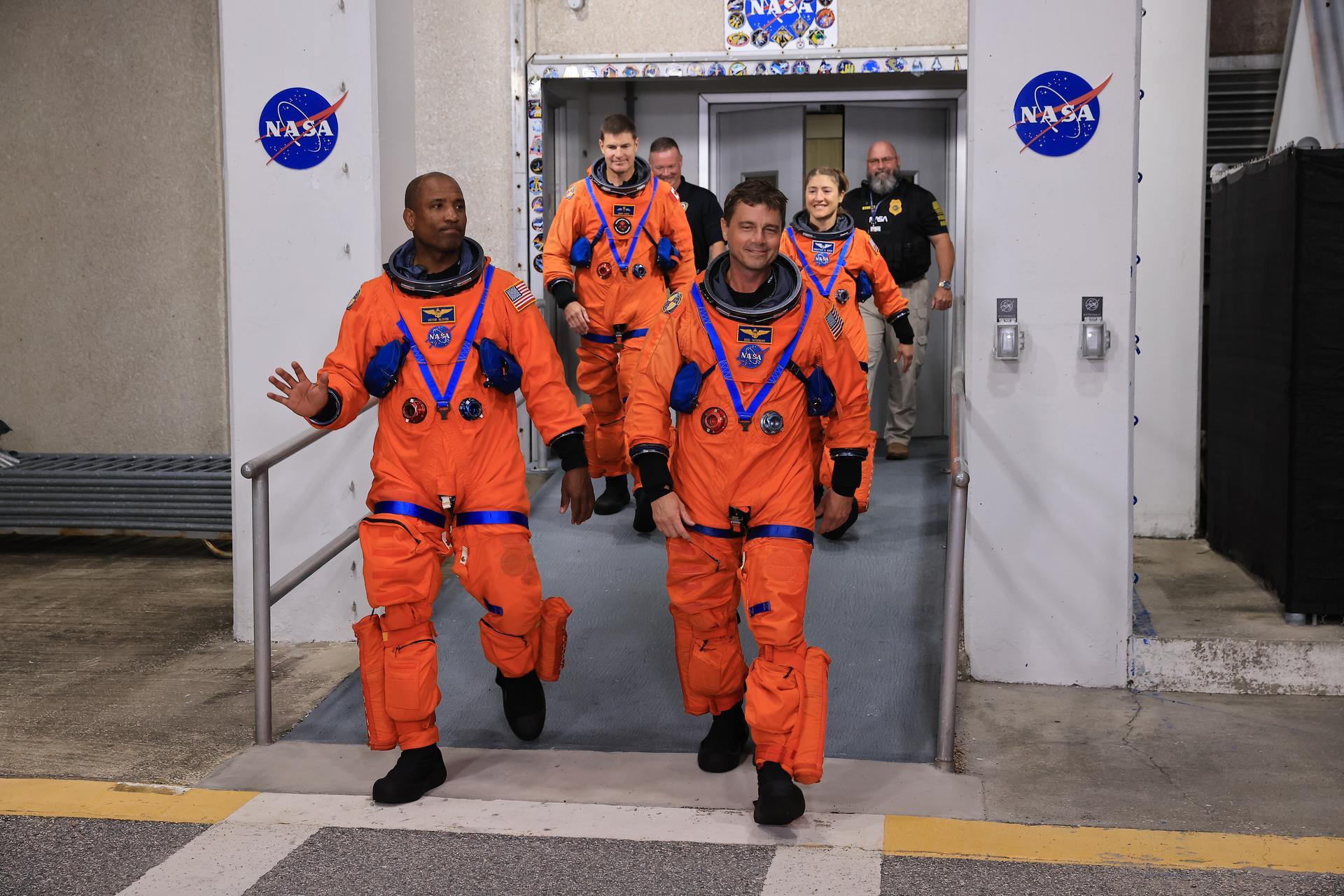
Before NASA’s Artemis II test flight launches a crew of four astronauts around the Moon and back, astronauts and teams on the ground at NASA’s Kennedy Space Center in Florida, are training for different scenarios that could take place on launch day.
On Aug. 11 and 12, teams with the agency’s Exploration Ground Systems Program along with NASA astronauts Reid Wiseman, Victor Glover, and Christina Koch, and CSA (Canadian Space Agency) astronaut Jeremy Hansen, practiced launch day operations if launch occurs at night. They simulated putting their spacesuits on and driving to the launch pad as well as emergency procedures they would use in the unlikely event of an emergency during the launch countdown requiring them to evacuate the launch pad.
During the first nighttime scenario, the crew traversed the nine-mile journey from crew quarters to Launch Complex 39B. Once the crew arrived, teams declared a “scrub” and the astronauts headed back to crew quarters like they would in the event of their launch being postponed. The test ensures both the crew and ground teams at Kennedy are prepared and understand the timeline of their events for launch day. Practicing the scenario also complements a September 2023 daylight version of the test.
On August 12, teams completed an emergency egress system demonstration inside Kennedy’s Vehicle Assembly Building (VAB). The astronauts suited up and departed their crew quarters and headed to the VAB, where their Moon rocket is being assembled on the mobile launcher. Once inside, the crew went up the mobile launcher to the White Room in the crew access arm – the area where the crew enters and exits their Orion spacecraft.

From there, teams went through different emergency scenarios with the astronauts, including practicing using emergency egress baskets while on the ground in the VAB.
During a real emergency, personnel will use the baskets, which are suspended on a track cable that connects the mobile launcher to the perimeter of the pad.
The team then headed to the terminus area at Launch Complex 39B, the location at the perimeter of the launch pad where the baskets will come to a stop in the event of an emergency. Once there, armored emergency response vehicles drove the team away to a designated safe site locations at Kennedy.
Teams will have another opportunity to practice different launch day scenarios with the Artemis II crew during a countdown demonstration test scheduled for later this year. Through the Artemis campaign, NASA will send astronauts to explore the Moon for scientific discovery, economic benefits, and to build the foundation for the first crewed missions to Mars – for the benefit of all.
Quelle: NASA
----
Update: 21.08.2025
.
NASA’s Final Piece of Artemis II Rocket Hardware Leaves Marshall
The final piece of Artemis II flight hardware for the SLS (Space Launch System) rocket departed NASA’s Marshall Space Flight Center in Huntsville, Alabama, Aug. 18, and will arrive at the agency’s Kennedy Space Center in Florida this week for integration with the rest of the rocket.
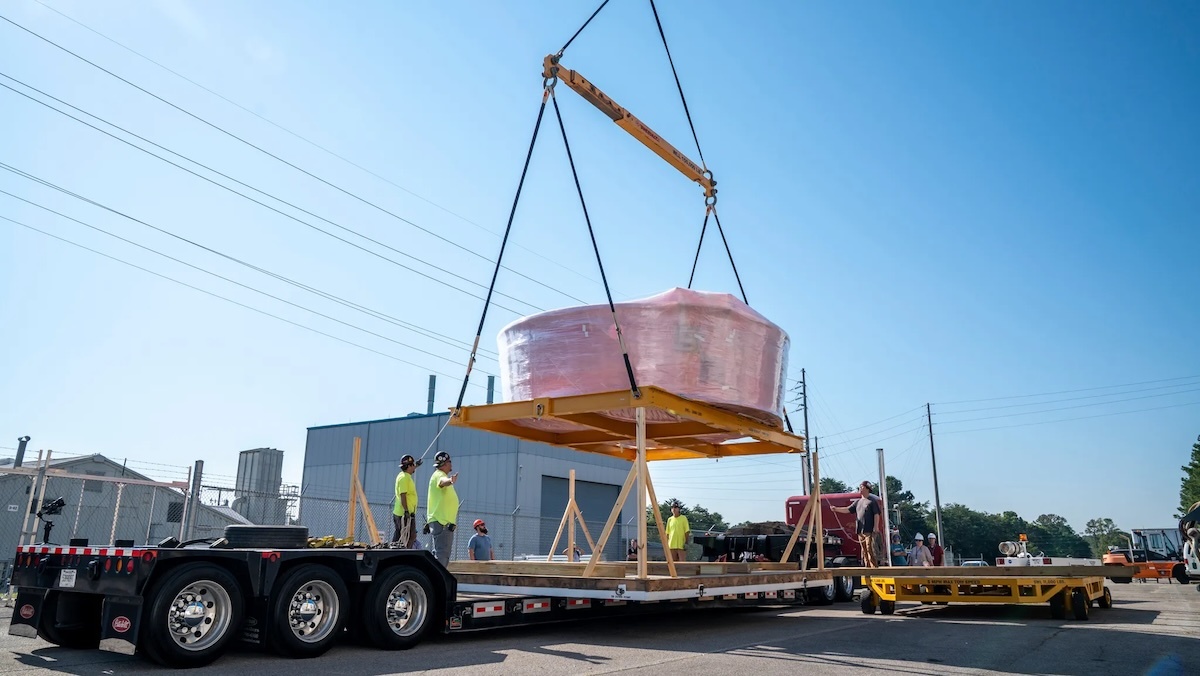
Built of lightweight aluminum at Marshall, the ring-shaped Orion stage adapter connects the interim cryogenic propulsion stage to the Orion spacecraft. A composite diaphragm within the ring acts as a barrier between Orion and the rest of the rocket, preventing gases – such as hydrogen – from entering the spacecraft. An auxiliary rendezvous target has been installed on the Artemis II Orion stage adapter for use by the astronauts during the planned proximity operations demonstration intended to test Orion’s handling capabilities.
The adapter was manufactured using friction stir welding in NASA Marshall’s Materials and Processes Laboratory. It’s the only piece of the SLS rocket built entirely by NASA engineers.
The adapter will also carry several CubeSats, which are small payloads containing science experiments and technology demonstrations intended to expand understanding of the space environment. Following separation from Orion, an avionics unit in the Orion stage adapter will send signals to release the payloads at pre-selected times. International partners South Korea, Germany, Argentina, and Saudi Arabia developed the four CubeSats aboard Artemis II.
As the Artemis II rocket is nearing completion at NASA Kennedy, teams continue work on flight hardware for Artemis III. Later this fall, NASA Marshall engineers will flip the third rocket’s Orion stage adapter and install the diaphragm.
Through Artemis, NASA will send astronauts to explore the Moon for scientific discovery, economic benefits, and build the foundation for the first crewed missions to Mars.
Quelle: NASA
----
Update: 19.09.2025
.
NASA Artemis II Moon Rocket Ready to Fly Crew
NASA’s Artemis II SLS (Space Launch System) rocket poised to send four astronauts from Earth on a journey around the Moon next year may appear identical to the Artemis I SLS rocket. On closer inspection, though, engineers have upgraded the agency’s Moon rocket inside and out to improve performance, reliability, and safety.
SLS flew a picture perfect first mission on the Artemis I test flight, meeting or exceeding parameters for performance, attitude control, and structural stability to an accuracy of tenths or hundredths of a percent as it sent an uncrewed Orion thousands of miles beyond the Moon. It also returned volumes of invaluable flight data for SLS engineers to analyze to drive improvements.
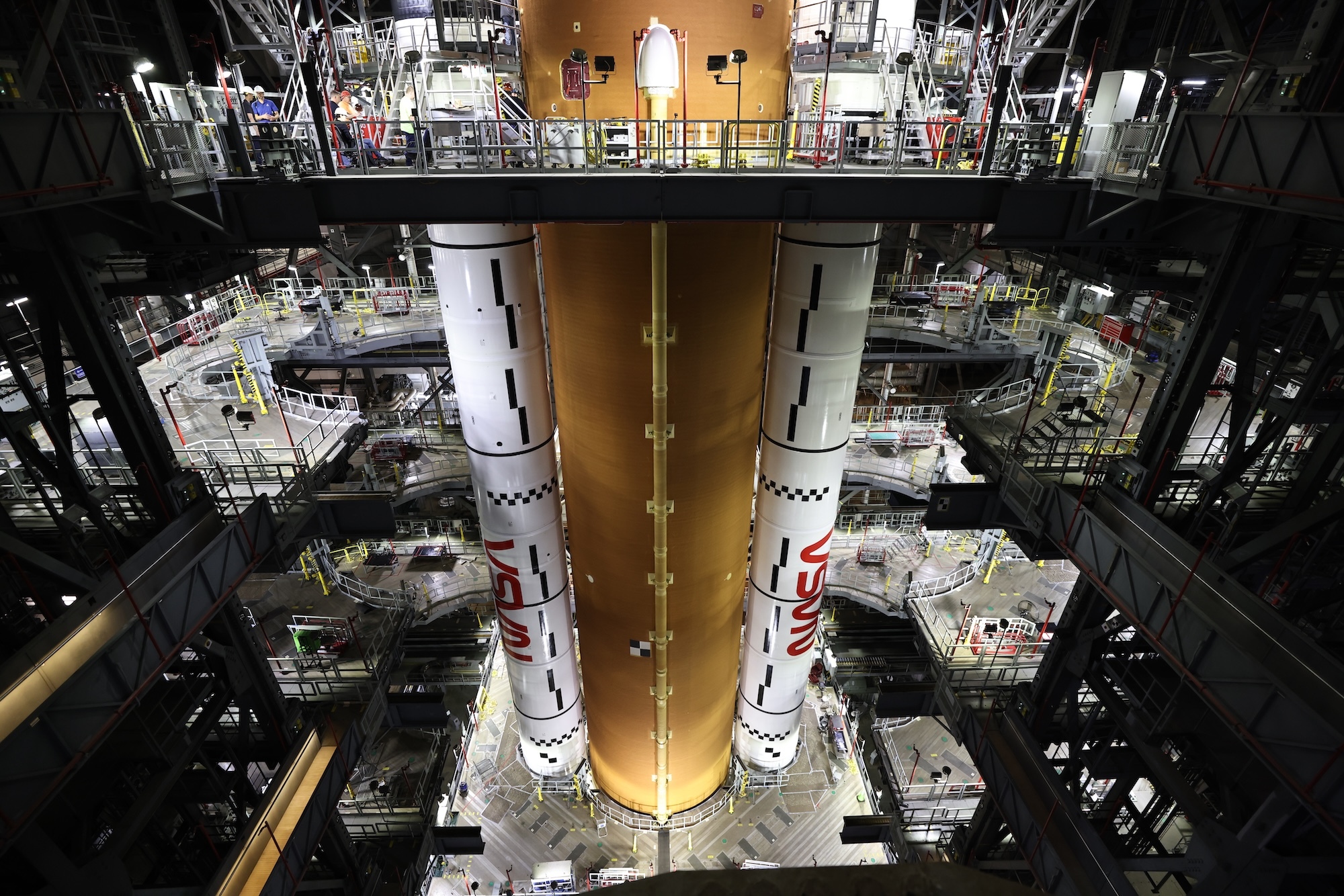
For Artemis II, the major sections of SLS remain unchanged – a central core stage, four RS-25 main engines, two five-segment solid rocket boosters, the ICPS (interim cryogenic propulsion stage), a launch vehicle stage adapter to hold the ICPS, and an Orion stage adapter connecting SLS to the Orion spacecraft. The difference is in the details.
“While we’re proud of our Artemis I performance, which validated our overall design, we’ve looked at how SLS can give our crews a better ride,” said John Honeycutt, NASA’s SLS Program manager. “Some of our changes respond to specific Artemis II mission requirements while others reflect ongoing analysis and testing, as well as lessons learned from Artemis I.”
Engineers have outfitted the ICPS with optical targets that will serve as visual cues to the astronauts aboard Orion as they manually pilot Orion around the upper stage and practice maneuvers to inform docking operations for Artemis III.
The Artemis II rocket includes an improved navigation system compared to Artemis I. Its communications capability also has been improved by repositioning antennas on the rocket to ensure continuous communications with NASA ground stations and the U.S. Space Force’s Space Launch Delta 45 which controls launches along the Eastern Range.
An emergency detection system on the ICPS allows the rocket to sense and respond to problems and notify the crew. The flight safety system adds a time delay to the self-destruct system to allow time for Orion’s escape system to pull the capsule to safety in event of an abort.
The separation motors that push the solid rocket booster away after the elements are no longer needed were angled an additional 15 degrees to increase separation clearance as the rest of the rocket speeds by.
Additionally, SLS will jettison the spent boosters four seconds earlier during Artemis II ascent than occurred during Artemis I. Dropping the boosters several seconds closer to the end of their burn will give engineers flight data to correlate with projections that shedding the boosters several seconds sooner will yield approximately 1,600 pounds of payload to Earth orbit for future SLS flights.
Engineers have incorporated additional improvements based on lessons learned from Artemis I. During the Artemis I test flight the SLS rocket experienced higher-than-expected vibrations near the solid rocket booster attachment points that was caused by unsteady airflow.
To steady the airflow, a pair of six-foot-long strakes flanking each booster’s forward connection points on the SLS intertank will smooth vibrations induced by airflow during ascent, and the rocket’s electronics system was requalified to endure higher levels of vibrations.
Engineers updated the core stage power distribution control unit, mounted in the intertank, which controls power to the rocket’s other electronics and protects against electrical hazards.
These improvements have led to an enhanced rocket to support crew as part of NASA’s Golden Age of innovation and exploration.
The approximately 10-day Artemis II test flight is the first crewed flight under NASA’s Artemiscampaign. It is another step toward new U.S.-crewed missions on the Moon’s surface that will help the agency prepare to send the first astronauts – Americans – to Mars.
Quelle: NASA
----
Update: 25.09.2025
.
Nasa plans first crewed Moon mission in 50 years for February 2026
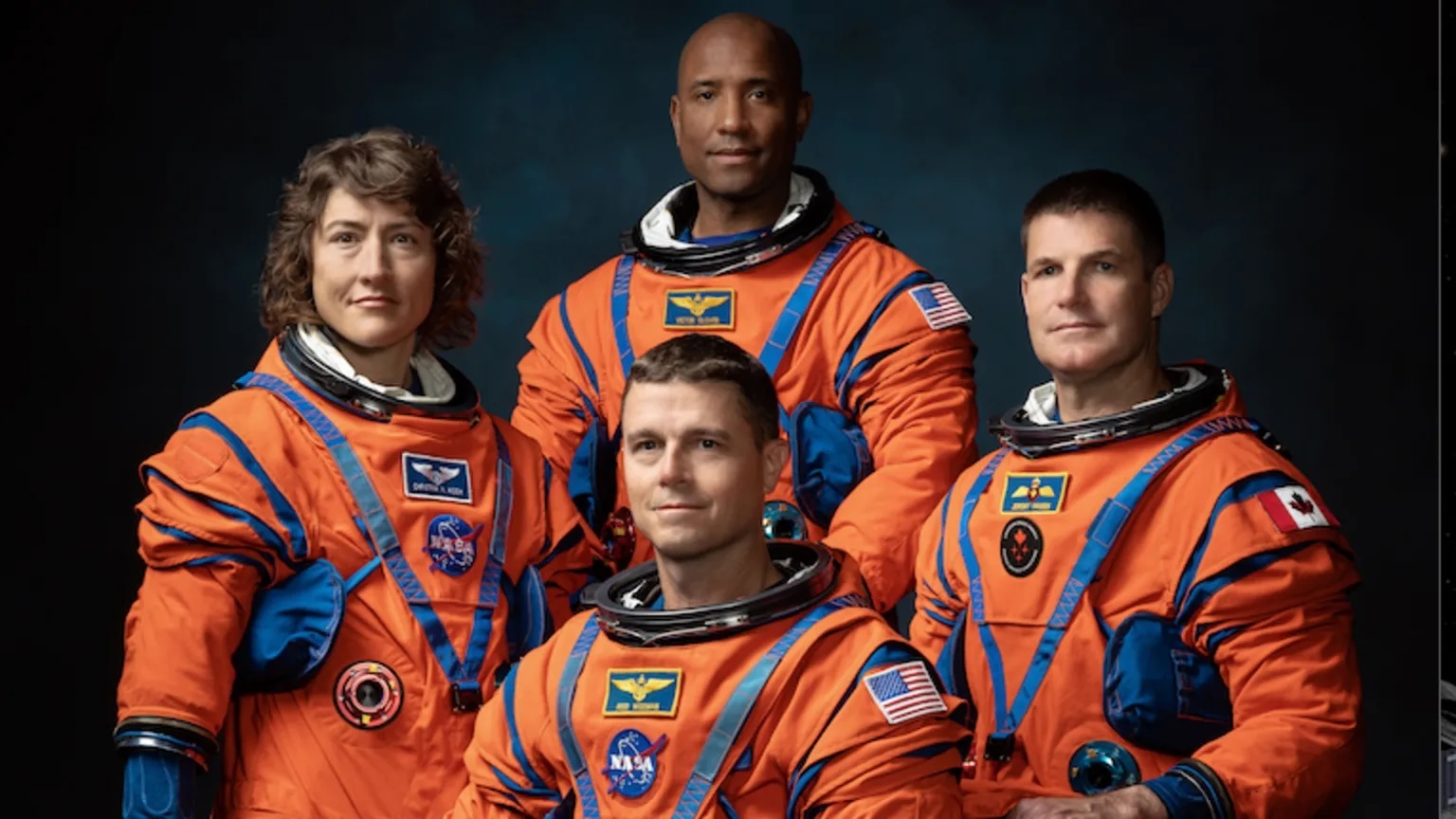
Artemis II Crew: left Christina Koch, back Victor Glover (pilot), front Reid Wiseman (commander), right Jeremy Hansen
Nasa has said it hopes to send astronauts on a ten-day trip around the Moon as soon as February.
The US space agency had previously committed to launching no later than the end of April but said it aims to bring the mission forward.
It's been 50 years since any country has flown a crewed lunar mission. Nasa will send four astronauts there and back to test systems.
The Artemis II mission is the second launch of the Artemis programme, whose aim is to land astronauts and eventually establish a long-term presence on the lunar surface.
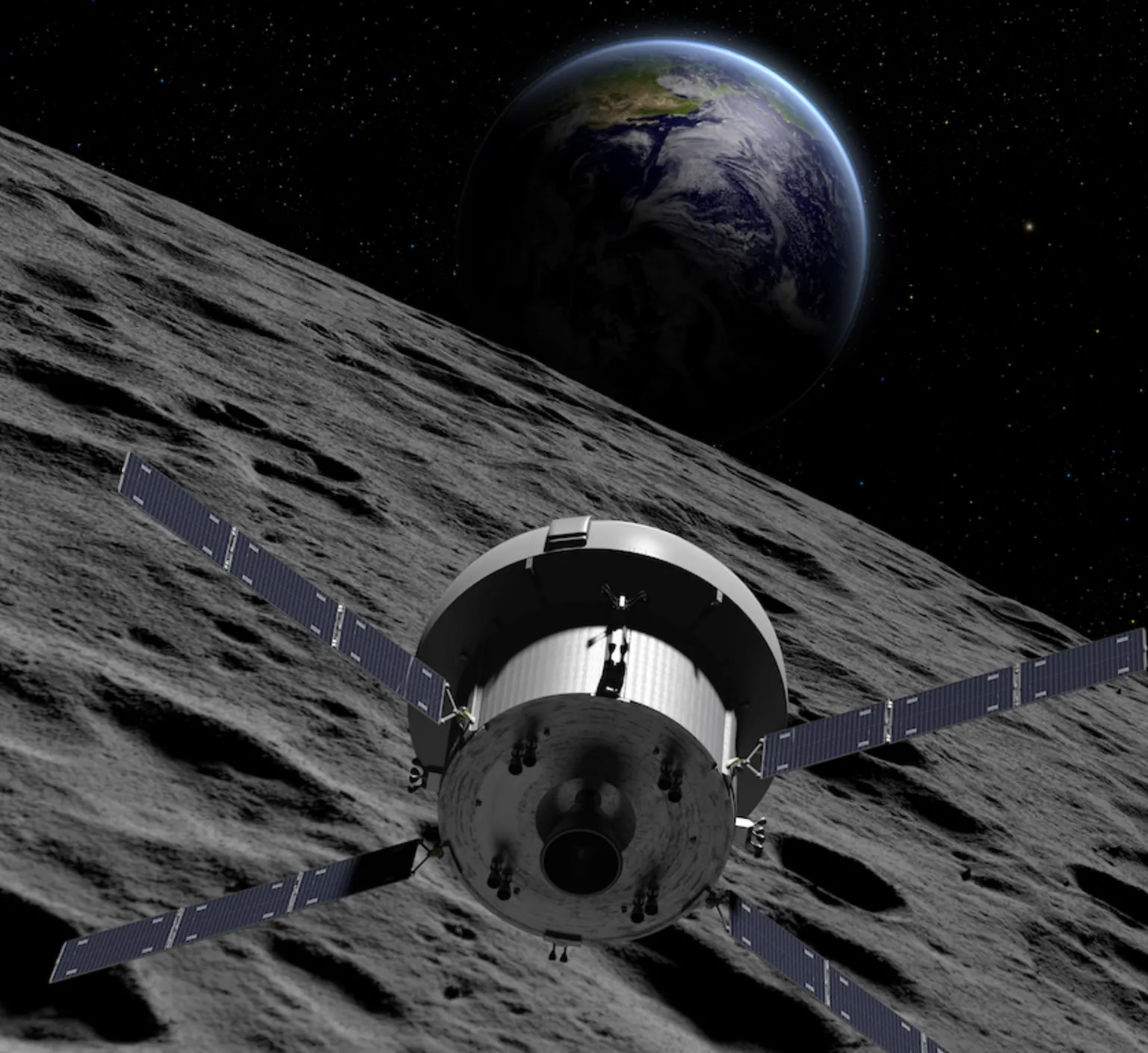
Artwork: Artemis II will be the first crewed lunar mission for more than 50 years
Lakiesha Hawkins, Nasa's acting deputy associate administrator said it would be an important moment in the human exploration of space.
"We together have a front row seat to history," she told a news conference this afternoon.
"The launch window could open as early as the fifth of February, but we want to emphasize that safety is our top priority."
Artemis Launch Director, Charlie Blackwell-Thompson explained that the powerful rocket system built to take the astronauts to the Moon, the Space Launch System (SLS) was "pretty much stacked and ready to go".
All that remained was to complete the crew capsule, called Orion, connected to SLS and to complete ground tests.
The first Artemis mission lasted 25 days and saw the launch of an uncrewed spacecraft in November 2022. It saw a spacecraft travel around the Moon and re-enter the Earth's atmosphere.
The mission was overwhelmingly successful, though there were issues with the heatshield as the spacecraft re-entered the Earth's atmosphere. These have since been addressed.
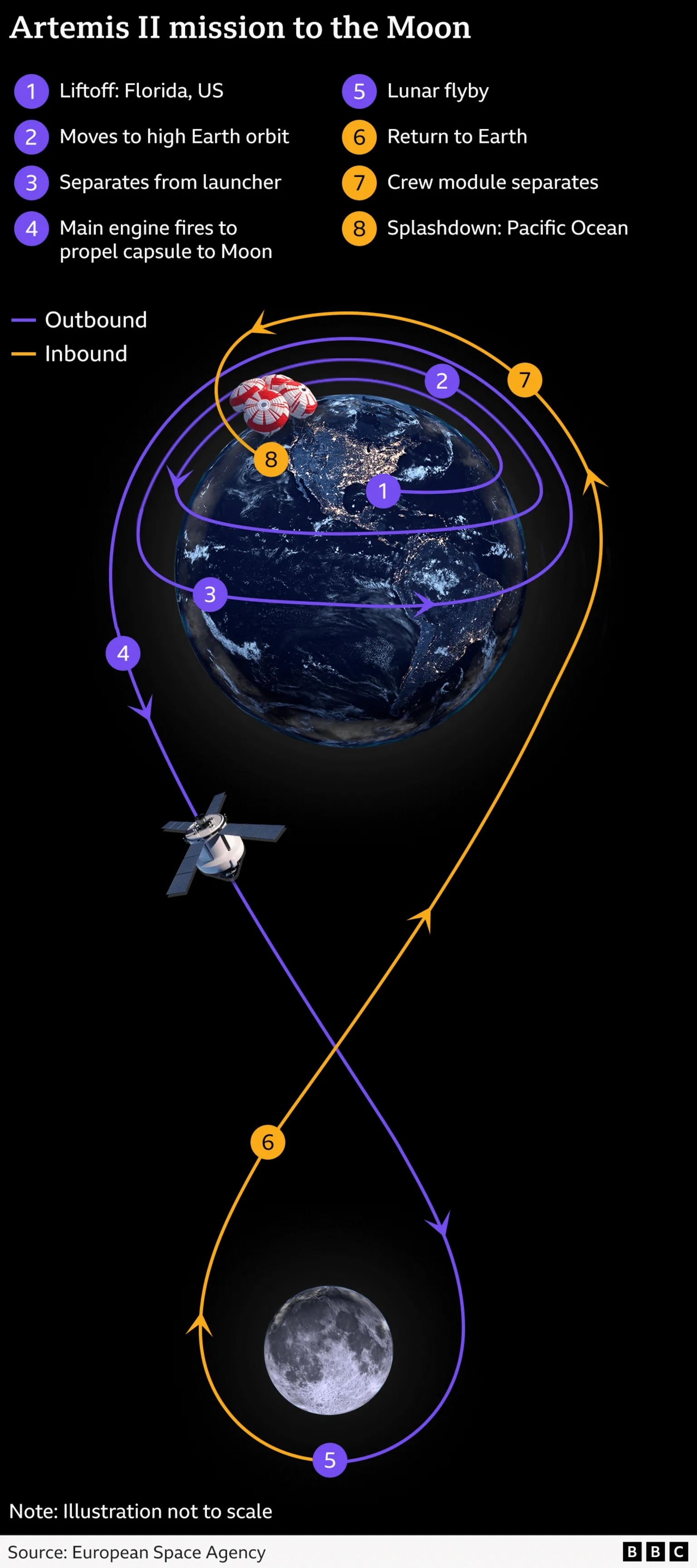
Source: European Space Agency
The Artemis II launch will see four astronauts go on a ten-day round trip to the Moon and back to the Earth. The astronauts, Reid Wiseman, Victor Glover, and Christina Koch, of Nasa and Jeremy Hansen of the Canadian Space Agency, will not land on the Moon, though they will be the first crew to travel beyond low Earth orbit since Apollo 17 in 1972.
The lead Artemis II flight director, Jeff Radigan explained that the crew would be flying further into space than anyone had been before.
"They're going at least 5,000 nautical miles (9,200Km) past the Moon, which is much higher than previous missions have gone," he told reporters.
The aim of the mission is to test the rocket and spacecraft's systems to lay the ground for a lunar landing.
The astronauts will enter the Orion capsule, which will be their home for the duration of their journey which sits on top of SLS.
This will be carried initially into Earth orbit with the help of two solid rocket boosters, which will fall back to Earth two minutes after launch once they have done the heavy lifting.
Eight minutes after launch the massive Core stage will separate from the second stage, called the Interim Cryogenic Propulsion System (ICPS), and the Orion crew capsule. Orion's solar arrays will unfurl and begin charging the spacecraft's batteries to provide power when it is not in direct sunlight.
Ninety minutes later ICPS fires its engines to raise the vehicle to a higher Earth orbit, and for the next 25 hours there will be a full systems check.
If everything is in order, Orion will separate from ICPS and there will be a form of "space ballet" between the two vehicles, more prosaically called the Proximity Operations Demonstration.
Astronauts will manually control Orion's manoeuvring thruster to dance toward and away from ICPS. This will be to rehearse docking procedures in order to link up with a landing vehicle for the eventual Moon landing.
Twenty-three hours later Orion's service module carries out a Translunar Injection (TLI) burn - a blast of thrust aiming it at the Moon - before Orion makes its four-day journey, taking the astronauts more than 230,000 miles from Earth.
During the journey the astronauts will be continue to carry out systems checks.
The crew will in some ways be human guinea pigs.
Experiments will monitor how their bodies are affected by space. Scientists will grow tissue samples from the astronauts' blood called organoids both before and after their journey.
The two sets of organoids will be compared to see how the astronauts' bodies have been affected by space, according to Dr Nicky Fox, Nasa's head of science.
"You may be wondering why we are doing all that when we have the actual astronauts, she told BBC News.
"We want to be able to study in depth the effect of the microgravity and the radiation on these samples. I'm certainly not going to dissect an astronaut! But I can dissect these little organoid samples and really look at the difference."
After the spacecraft slingshots past the Moon, the astronauts begin their four-day journey home, drawn back with the help of the Earth's gravity.
On arrival, the service module, which has the spacecraft's primary propulsion system, separates from the crew module. The astronauts will then begin a dangerous part of the mission as they re-enter the Earth's atmosphere, and parachute back to the surface off the coast of California.
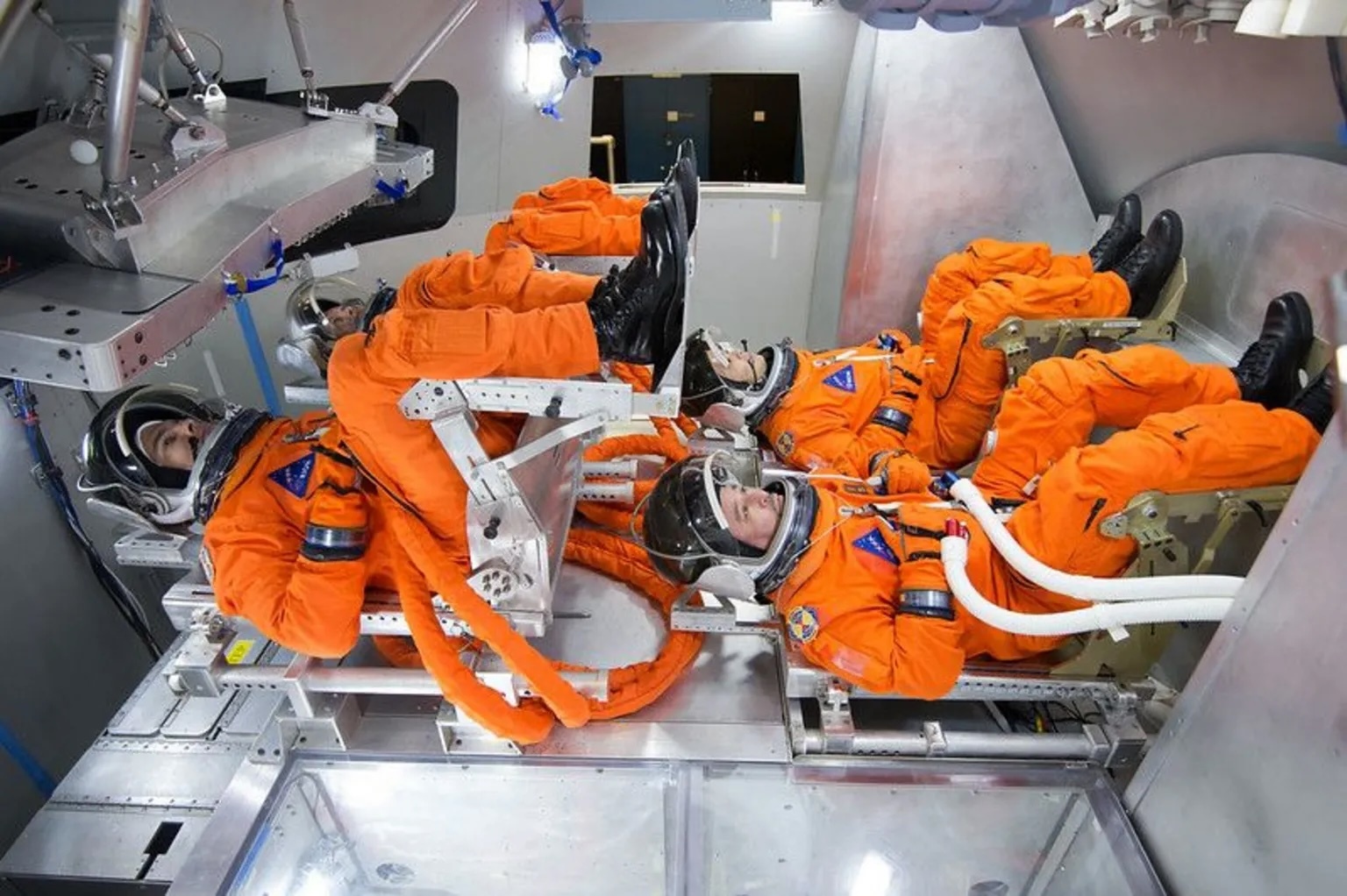
Spacesuit engineers demonstrate how four crew members would be arranged for launch inside the Orion spacecraft
The success of the mission will determine how soon Nasa can launch Artemis III, to actually land on the Moon. But even if the mission goes to perfection, the space agency's stated aim of "no earlier than mid-2027" is unrealistic, according to Dr Simeon Barber of the Open University.
"'No earlier than' is familiar language for NASA, and it means just that. That's the earliest possibility," he said, adding that he deemed that optimistic due to the expense of keeping Artemis III on track.
"The Moon landing will require [Elon Musk's] SpaceX Starship to take the astronauts to and from the surface, and we've seen in recent months that Starship itself still has a long way to go before it can even achieve an orbital flight around the Earth, let alone put astronauts on board."
Quelle: BBC
----
Update: 5.12.2025
.
NASA reveals 'America 250' logo on rocket launching crew to moon

NASA astronaut Reid Wiseman, commander of the upcoming Artemis II mission to the moon, recently remarked that flying during the United States' 250th anniversary has definitely got him and his crew "fired up."
Wiseman was referring to the excitement that their flight is adding to the already milestone year, but as it turns out, he could have been speaking literally. As NASA revealed this week, the two side-mounted motors that will provide the majority of the thrust during the Artemis II crew's launch have been adorned with the nation's logo marking the 250 years since the signing of the Declaration of Independence.
"The America 250 emblem is now on the twin solid rocket boosters of the SLS (Space Launch System) rocket for Artemis II — the powerhouse that will launch a crew of four around the moon next year," read NASA's announcement. "Unveiled on Tuesday, the design echoes the America 250 Commission's Spirit of Innovation theme, honoring a country that has never stopped pushing the horizon forward."
The red, white and blue emblems, which each measure 8 feet high by 11.8 feet wide (2.4 by 3.6 meters), were added inside the Vehicle Assembly Building (VAB) at NASA's Kennedy Space Center in Florida. Workers carefully painted each logo after the SLS had been fully stacked and topped off with "Integrity," the Orion spacecraft that will carry Wiseman, pilot Victor Glover and mission specialists Christina Koch and Jeremy Hansen on the mission.
The 10-day Artemis II mission, which is targeted to launch no earlier than Feb. 5 (and no later than April 2026), will mark the first time that humans have returned to the vicinity of the moon since the last Apollo mission in 1972. The flight will not enter orbit around he moon, but rather follow a "free-return" trajectory that will take the crew further out from Earth than ever before.
The America 250 "design's ribbons are intended to evoke a sense of commemoration, celebration and purpose, while the flowing red, white, and blue ribbons form the number 250 as a single continuous path, representing the unity, cooperation and harmony we strive for as a country," according to the semiquincentennial commission.
The logo was created in partnership with Chermayeff & Geismar & Haviv, the same firm where Bruce Blackburn designed the nation's bicentennial emblem. Among other places, the 1976 logo was added to the exterior of NASA's VAB, where it remained in place for 22 years.
Blackburn also collaborated with Richard Danne to create NASA's logotype, affectionally called the "worm," which was first introduced in 1975, retired in 1992 and then resurrected alongside the space agency's original and official insignia ("the meatball") in 2020. Just as it was on the uncrewed Artemis I mission in 2022, the Artemis II solid rocket boosters also feature the worm.
"When I look at 2026, the year ahead, we're going 250,000 miles from planet Earth and just coincidentally, it happens to be the 250th anniversary of the United States of America," said Riseman. "So we'll see if we can play those two numbers together just a few thousand times on this mission."
Quelle: CS
